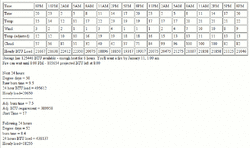After measuring weight of wood burned for some time now, it occurred to me that there would be an easy formula to take the guess work out of determining how much wood to burn to recharge storage. This does involve weighing the wood, which I have found to be quite easy to do. The formula:
This formula can be reduced once you know a couple of variables. For example, I have 1000 gallons of storage. My target end storage temperature might be 185. I will assume boiler efficiency at 75%. I will assume wood energy at 6050 btu/lb. The reduced formula is:
Example: storage starts at 107. Then I need (185 - 107) x 1.84 = 144 lbs of wood to burn to bring storage up to 185. Of course, degree of tank insulation will also affect the result, but without much effort you could develop your customized formula.
Gasser boiler efficiency between 75-80% probably is quite typical. Wood energy is about 6050 btu/lb, assuming 20% MC and 400F stack temp.
If anyone tries this, let me know the results. It works quite well for me.
Code:
Weight of wood to burn
(Storage end temperature - storage begin temperature) x gallons of storage x 8.34
= __________________________________________________________________________________
boiler efficiency x wood energy/lbThis formula can be reduced once you know a couple of variables. For example, I have 1000 gallons of storage. My target end storage temperature might be 185. I will assume boiler efficiency at 75%. I will assume wood energy at 6050 btu/lb. The reduced formula is:
Code:
Weight of wood to burn
(185 - storage begin temperature) x 8340
= _________________________________________
0.75 x 6050
= (185 - storage begin temperature) x 1.84Example: storage starts at 107. Then I need (185 - 107) x 1.84 = 144 lbs of wood to burn to bring storage up to 185. Of course, degree of tank insulation will also affect the result, but without much effort you could develop your customized formula.
Gasser boiler efficiency between 75-80% probably is quite typical. Wood energy is about 6050 btu/lb, assuming 20% MC and 400F stack temp.
If anyone tries this, let me know the results. It works quite well for me.




